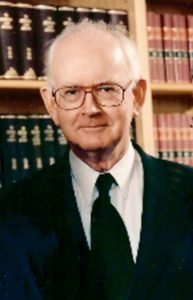Lawyers, Milestones or Millstones for the Rule of Law in the Independent State of Papua New Guinea: a memoir
Part TWO: Paul Munro AM
Moving from Part One of this memoir to focus on the topic of Rule of Law, in 1960, as in 2025, no more important icon of sociolegal discipline exists than the concept of the rule of law. No more concrete symbols of legal presence exist than the court buildings: emblems of nationhood, housing legal proceedings and staff. Yet, as in the 1960s, both topics lend more easily to ridicule and distortion than to earnest discussion and respect.
There are stacks of alternative criteria for defining what is meant by the rule of law.1 It is enough here to identify the concept of equality of everyone, including governments under duly made laws, consistently applied and enforced, overseen by independent, impartial judiciaries. For me, there is a well framed criterion against which to test the resilience of the rule of law in national systems. It asks— whether the people with authority to make, administer and apply the rules are accountable and actually administer the law consistently and in accordance with its tenor.2 Let me tag that as the Finnis test.
The Constitution of the Independent State of PNG and the laws received on Independence are a monument to the general capabilities marshalled across Crown Law and the drafting networks engaged. To quote Justice Logan, ‘The PNG Constitution enshrines, rather than leaves unstated but assumed, certain elements of [our] understanding of the rule of law.’
All great monuments are built by the work of many hands and minds. For this article, recognition of the Crown lawyers generally, whether at Konedobu, ASOPA or Department of External Territories (DOET), must be confined to a few endnote references.
Instead, my focus is upon four instances, milestones, of conduct that I believe shaped how rule of law principles took sometime precarious root in the growth of PNG to and through nationhood.
The first two instances were responses by Public Solicitor officeholders. I was indirectly involved in the first. I had worked closely with the key figure in the second. John Greville-Smith and Peter Lalor were men of markedly different character and background, but they had some things in common. Both held the office of Pubsol for a time, both became Presidents of the PSA; each had strong commitments to ethical principles of legal representation for those in need of it. Courage and integrity in responding to pressures challenging those values are demonstrated in the conduct I recount.
My first milestone is less widely known than others. It arose out of an attack upon an administration patrol in late May to early June 1961. A police investigation resulted in charges for indictable offences being laid against the patrol officer involved and one of his accompanying Royal PNG Constabulary (RPNGC) members, Sergeant Gonene. Sgt Gonene was committed for trial for wilful murder in Goroka on 25 January 1962. As junior counsel to Greville-Smith, I was part of the defence team for Gonene. Alerted by an observation arising from the committal proceedings, Smith sought authorisation to secure evidential support from a Brisbane-based ballistic expert. The Secretary for Law, I believe, refused Smith’s requisition for the expense involved. Smith defied the constraint and authorised travel, etc. out of his PubSol budget. In a public service environment conditioned to discourage dissent, Greville-Smith manifested courage, integrity and perseverance in representational duty.
Contrary to suggestions by some commentators, the resultant evidence for the defence that evidence did not cause the Crown case to be ‘inconclusive’. It demolished that case, shredding its premises. Greville-Smith was firmly of the view that Gonene was entitled to immediate acquittal. Instead, to save face (not for the only time in this memoir), the Crown withdrew the indictment. There was no revival of the charges. Gonene was reinstated, resumed his uniform and duties, and was promoted in due course to a higher rank.3
My second instance is much better documented, extraordinarily by an official publication: DFAT Docs Aust/PNG 1966–69. An extended comment about negotiations with Conzinc Riotinto of Australia’s (CRA) mining venture on Bougainville narrates the pressures applied to Peter Lalor as Public Solicitor in 1968. A slice of extracts indicates the nature of what became six months of pressuring:
In October 1968 DOET, received news [a telex from Administrator David Hay], that the PNG Public Solicitor, acting on behalf of indigenes, was considering a legal challenge to the validity of the Territory’s Mining Ordinance. Having decided to face litigation, Canberra took a tough line. Here, Peter Lalor, the Public Solicitor, became a target. He was told that the department was aware of a speech he had given … and threatened that if he were to publicly oppose our legislation he could expect us to use his own address against him. Early consideration was given to abolishing his position … [indeed the incumbent Konedobu Secretary for Law canvassed that option, reflecting upon Lalor’s allegedly being: ‘irresponsible administratively, an indifferent lawyer but a good advocate’] … but the final conclusion was that the Minister should reserve the right to discontinue his funding.4
Lalor persevered and took his challenge to the High Court which ruled against it, but he had fulfilled his duty to his clients.
Those instances are among many others that almost certainly could be documented by those who followed in Public Solicitor roles. Together, they may serve to explain why the PNG Constitution established the Public Solicitor as a Constitutional Office-Holder appointed by the Judicial and Legal Services Commission, with constitutionally defined functions and protections, including resource allocation.5 Constitutional enshrinement of rights to legal representation, let alone a public defender agency, is exceptional. That enablement has been and continues to be a substantial plank in PNG’s platform for sustaining the rule of law.
The third and fourth milestones both mark stages in establishing community respect for the judicial agencies. In my experience of both criminal and civil proceedings from 1961–66, virtually all my Papuan or New Guinean clients saw any court as just another arm of government: ‘samting bilong gavman, bilong yupela tasol’. I thought most accepted I was on their side, but with bemusement because I had said I was, and most ‘laik winim kot’.
Paul Quinlivan’s early experience brought him within reach of mentoring by Justice Sir Beaumont Phillips. It exposed him to Phillips’ intense and persevering efforts to have villagers better understand his Supreme Court sittings as part and parcel of their lives. Paul’s consolidated ‘Snapshots’, published on the PNGAA website, elaborate on that rationale and practice. Quinlivan, as Senior Stipendiary Magistrate in Rabaul, adopted a similar approach. He was at all times committed to performing judicial functions in a manner that would build respect for courts. He went to lengths to have courts seen by all as fair, well informed and communicative agencies for determining matters in contest.
His perseverance with that commitment provoked a hostile reaction in the Rabaul Multi-Racial Council trespass and damage to property case in 1969. A fuller story can be found elsewhere.6 Some Tolai leaders shut down the council buildings, were arrested and locked away. Fierce public and behind-the-scenes interplay followed, involving Quinlivan, the Secretary for Law, and Canberra bureaucrats. As a magistrate, he was soon presented with the task of dealing with some rather lightweight charges against three accused. His judgment, at length, dismissed the charges drawing upon legal precedent and the surrounding circumstances, including facts attested in cogent supportive evidence as part of the Crown case from then District Commissioner Harry West.
Unequivocally, Quinlivan’s decision was founded upon his commitment to maintaining respect for the integrity of his court and upholding the rule of law. Canberra and the incoming Konedobu Secretary for Law, Lindsay Curtis, did not see it that way. Almost immediately, they acted to have Quinlivan removed from his position in Rabaul. When that eventuated, for Paul and his family, the disruptive relocations involved were traumatic.
Conversely, his approach to the administration of justice resonates to this day. Upon Paul’s death in 2017, Sir John Kaputin published widely an extensive tribute including:
To our Tolai people in Rabaul, he will remain in memorial in our hearts for giving us the recognition, dignity and respectability and in so doing, he was prepared to stand up to Canberra and uphold the rule of law as the legal guiding principle in his judgement in which he cited the nationalist Scottish people as the rightful owners of the Crown Jewels as a precedent.
My fourth milestone marks a pivotal, post-independence point for the judicial structure and values. Again, much of the story is public knowledge. In mid-1979 the Minister for Justice, Nahau Rooney, persisted with recriminations against an interim injunction of the National Court restraining a decision by the Minister to revoke a non-national UPNG lecturer’s entry permit. The Supreme Court later convicted Rooney of contempt and sentenced her to eight months imprisonment with light labour. Chief Minister Somare set her free after one day pending an appeal to a non-judicial Mercy Committee. As a direct result, five judges, including the Chief Justice and Deputy CJ, resigned from late 1979 to early 1980.7 The resignations led to the first indigenous lawyer to be appointed to the National and Supreme Courts, Mari Kapi, on 1 December 1979. It was not until August 1980 that a replacement for the Chief Justice was filled by the appointment of Buri Kidu, who served from 1980 to 1993.
Academic Don Denoon was correct when he wrote that: ‘The spur to localising judicial offices was the bench of [Australian] judges, not the Government’. However, I believe Denoon was mistaken, attributing to Hal Wooten ‘a willingness to take over as Chief Justice, but the Government began a program of localisation’. A year or so before Hal’s death in 2021, I had a recorded conversation with Wooten about the 1966-67 Local Officers Case. We also had some exchanges tangential to that topic. I clearly understood that Somare had invited Wooten to be CJ, but Wooten persuaded Somare that the appointment of Kidu was the better option; he supported that contention by withdrawing in favour of Buri Kidu.
I include that event and outcome as a milestone for two reasons. Hal Wooten is widely acknowledged for his diverse and career-long contributions to the development of PNG’s legal and other structures toward nationhood. He should be honoured also for his insight, devoid of self-interest.
One measure of the magnitude of that contribution is the almost universal acclaim of Sir Buri Kidu’s performance as PNG Chief Justice. Almost universal, because despite his 13 years’ service, he was denied renewal of appointment, leaving him two years short of entitlement to pension. From my sources over the years, I heard only high praise for Buri Kidu’s leadership and lawyering. Justice Logan is experienced in appellate court levels in both Australia and PNG.
In 2022, he wrote:
An immediate legacy of the judicial resignations which were a sequel to the Rooney affair was a need in short order to appoint a new Chief Justice and other superior court judges. In this regard, it is impossible to overstate the value of the service rendered to the nation by the Honourable Sir Buri Kidu, in the respectful memory of whom this lecture series is named, in assuming the office of Chief Justice in the wake of these resignations. Under his leadership, the doing of justice according to law in Papua New Guinea, as contemplated by the PNG Constitution, was maintained. Papua New Guinea was blessed by his service, as it has been by that of his successors in office.8
In the celebration of 50 years of PNG’s independence, the chance must also be taken to review, perhaps audit, progress against promise. The promise was embodied not only in legislation, in hopes and aspirations, but in people. At their best, they strove toward and modelled what might be needed for optimally establishing a viably independent nation. Most readers of PNG Kundu will be familiar with shortfalls and disappointments in PNG governance, societal welfare, law and order. The milestones recalled are intended to show the linkages between past events, figures, models and present structures and conduct. My review for this memoir took me to a bundle of sources. Most point out the scope for improvements or reforms, but none of them do other than endorse a view that the legal structural element of the rule of law is in reasonably good health for the Independent State of PNG on its 50th birthday. The same may not so readily be said in the application of the Finnis test to other agencies and principles of PNG.
But to condemn failure to satisfy that criterion, which anglophone-developed nation is in a position to cast the first stone?



